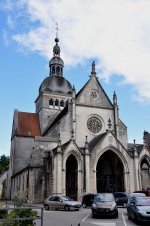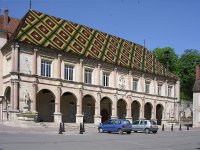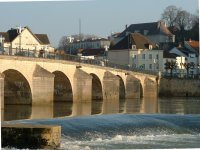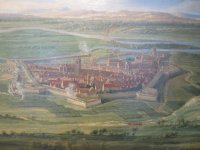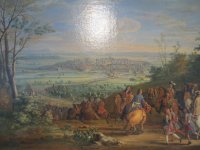52 BC
Per the narrative, the Battle of Alesia or Siege of Alesia was a military engagement in the Gallic Wars around Alesia in modern France. It was fought by the Roman army of Julius Caesar against a confederation of Gallic tribes united under the leadership of Vercingetorix of the Arverni. It was the last major engagement between Gauls and Romans, and is considered one of Caesar's greatest military achievements and a classic example of siege warfare and investment; the Roman army built dual lines of fortifications - an inner wall to keep the besieged Gauls in, and an outer wall to keep the Gallic relief force out. The Battle of Alesia marked the end of Gallic independence in modern day territory of France and Belgium.- It was the battle in which Julius Caesar beat the Gauls under Vercingetorix, thus bringing France into the Roman world.
- The battle site was probably atop Mont Auxois, above modern Alise-Sainte-Reine in France, but this location, some have argued, does not fit Caesar's description of the battle.
- A number of alternatives have been proposed over time, among which only Chaux-des-Crotenay remains a challenger today.
- For many years, the actual location of the battle was unknown.
- Competing theories focused first on two towns, Alaise in the Franche-Comté and Alise-Sainte-Reine in the Côte-d'Or.
- Emperor Napoleon III of France supported the latter candidate, and, during the 1860s, funded archaeological research that uncovered the evidence to support the existence of Roman camps in the area.
- Uncertainty has nevertheless persisted, with questions being raised about the validity of Alise-Sainte-Reine's claim.
- For example, the site is said to be too small to accommodate even revised estimates of 80,000 men with the Gallic infantry, along with cavalry and additional personnel.
- It is also alleged that the topography of the area does not fit with Caesar's description.
- In the 1960s, a French archaeologist, André Berthier, argued that the hill top was too low to have required a siege, and that the "rivers" were actually small streams.
- Berthier proposed that the location of the battle was at Chaux-des-Crotenay at the gate of the Jura mountains – a place that better suits the descriptions in Caesar's Gallic Wars.
- Roman fortifications have been found at this site. Danielle Porte, a Sorbonne professor, continues to challenge the identification of Alise-Sainte-Reine as the battle site, but the director of the Alesia museum, Laurent de Froberville, maintains that scientific evidence supports this identification.
- Classical historian and archaeologist Colin Wells took the view that the excavations at Alise-Sainte-Reine in the 1990s should have removed all possible doubt about the site and regarded some of the advocacy of alternative locations as "...passionate nonsense".
- Precise figures for the size of the armies involved, and the number of casualties suffered, are difficult to know.
- Such figures have always been a powerful propaganda weapon, and are thus suspect. Caesar, in his De Bello Gallico, refers to a Gallic relief force of a quarter of a million, probably an exaggeration to enhance his victory.
- Unfortunately, the only records of the events are Roman and therefore presumably biased.
- Modern historians usually believe that a number between fifty thousand and one hundred thousand men is more credible.
- Hans Delbrück estimated perhaps twenty thousand men in the fort and fifty thousand in the relief force, although he considered even these numbers as too high.
- Julius Caesar's firsthand account of the Gallic Wars, written as a third-person narrative.
- In it Caesar describes the battles and intrigues that took place in the nine years he spent fighting the Celtic and Germanic peoples in Gaul that opposed Roman conquest.
- Commentaries on the Gallic Wars
- The original publication time of the Bello Gallico is uncertain.
- It had been definitely published by 46 BC, when Cicero reviewed it and gave it great praise.
- It is unclear whether the books were released invididually, or all at once.
- Nipperdey's 1847 account believed that they had been mostly all composed at once in 50 BC.
- Frank Adcock suggested in 1956 that they had been written in stages, but then published simultaneously.
- T. P. Wiseman believed they were written and published yearly, as Caesar would have gained enormous utility from keeping the public informed about his exploits.
- The debate as to the time and nature of publication continues, with critical examination of the evolution of the writing style the chief tool for dating the work.
- Even if the works were published after the wars, it was clear that Caesar was waging a propaganda campaign during the war, including writing copious letters to his political allies back in Rome.
- Because of the questionable nature of the war, and threats by his enemies to have him essentially tried for war crimes, winning the public relations battle was critical for Caesar.
- Since the work of Karl Nipperdey in 1847, the existing manuscripts have been divided into two classes.
- The first (α) encompasses manuscripts containing only De Bello Gallico and characterized by colophons with allusions to late antique correctores.
- The oldest manuscript in this class is MS. Amsterdam 73, written at Fleury Abbey in the later ninth century.
- The second (β) encompasses manuscripts containing all of the related works - not only De Bello Gallico, but De Bello Civili, De Bello Alexandrino, De Bello Africo, and De Bello Hispaniensi, always in that order.
- The oldest manuscript in this class is MS Paris lat. 3864, written at Corbie in the last quarter of the ninth century.
- For De Bello Gallico, the readings of α are considered better than β.
- The editio princeps was published by Giovanni Andrea Bussi at Rome in 1469.
- I was unable to find when MS. Amsterdam 73 and MS Paris lat. 3864 were discovered, and by whom. From previous experiences I'd be very surprised if that happened prior to the year 1418.
Melchior Feselen
The battle of Alesia was on my mind ever since I saw this anachronistic "1533" painting by Melchior Feselen. You know that something ain't right, when a dude of this talent has a three bullet long wiki page.- Melchior Feselen, an historical painter, of Passau, lived at the same time as Altdorfer, whose works he imitated with assiduity.
- Though he was inferior to that artist, his paintings are rich in composition, with a great number of figures highly finished, and in a style quite peculiar to himself.
- He died at Ingolstadt in 1538.
They obviously were not supposed to have cannons in 52 BC, but according to Feselen they did. This in turn prompts the question of when this event really took place.
We can clearly see, that in Feselen's opinion dated with 1533, Alesia was situated on the banks of some river. Yet, the narrative compliant site of Alesia has no such body of water next to it.
There are two insignificant creeks. These are too small to account for what we see in the painting:
Alesia
Alesia was the capital of the Mandubii, one of the Gallic tribes allied with the Aedui. The Celtic oppidum was conquered by Julius Caesar during the Gallic Wars and afterwards became a Gallo-Roman town. Modern understanding of its location was controversial for a long time; however, it is now thought to have been located on Mont-Auxois, near Alise-Sainte-Reine in Burgundy, France.- After being conquered by Caesar, Alesia became a Gallo-Roman town. It featured a town centre with monumental buildings such as temples and a forum. There was also a theatre.
- KD: Really? That's just some amazing info. Where did it come from?
- He was writing a biography of Caesar and saw the command of Vercingetorix over all Gaulish armies as a symbol of the French nation.
- At the same time he realized that the future French nation was heavily influenced by the Roman victory and centuries of rule over Gaul.
- Napoleon ordered an archaeological excavation by Eugène Stoffel around Mont-Auxois.
- These excavations in 1861–65 concentrated on the vast Roman siege lines and indicated that the historical Alesia was indeed located there.
The oppidum was located on a plateau of c. 97 hectares (240 acres), around 200 metres (660 ft) above the valley floor, surrounded by steep cliffs in every direction except at the eastern and western extremities.
- It was protected by a wall (Murus Gallicus) enclosing an area of up to 140 hectares, pierced by at least two pincer gates and in 52 BC it possibly had a population of 80,000 including refugees and men under the command of Vercingetorix.
- Franco-German excavations led by Michel Reddé and Siegmar von Schnurbein in 1991- 97 confirmed these findings and effectively ended the long debate among archaeologists about the location of Alesia.
Reddé + von Schnurbein

Alesia = Alexia
Isn't it it interesting that just about everything was renamed at some point? I approached this "Alesia" research from this exact point. I'm not saying that this is the ultimate truth, but here is what we have.Alesia = Alexia
Note: Romans brought them construction materials with them, right? Wiki:
- The Roman army built dual lines of fortifications - an inner wall to keep the besieged Gauls in, and an outer wall to keep the Gallic relief force out.
Blind Me
Feel kind of embarrassed, but I should have noticed this "Alexia" thing before. The word is front and center on the Melchior Feselen's painting.This lead me to the following 1885 text.
Translation:
- Quanta strage virum sublimis Alexia cessit Caesaris aquilis picta tabella notat.
- Lat-Eng: Alice had made an excellent yield of the emperor Eagles. Painted stamps.
- I have no idea what the actual translation is. Commas and dots change the entire meaning of the phrase.
- At the same time there is no word "Julius" in this phrase. Where did they get Julius Caesar?
This is the tree trunk they are talking about.
Chronology
- IS33 - this I am not going to play with, for I have no idea what it could mean.
- i533 could be factored into Fomenko's chronology. In this case we have:
- 1152 + 533 = 1685 AD
- Considering that Alesia is in France, this is the time frame we might entertain for the Battle of Alesia.
Location
We are being told that the Battle of Alesia site was atop Mont Auxois. Let's built a point of reference to better understand the suggested location. As you can see, they want us to think that the Battle of Alesia took place approximately 27.5 miles North-West of Dijon.It requires a bit of talent to loose something easily referenceable, but it requires some special talent to find what you lost at a location it never was.
- The earliest archaeological finds within the city limits of Dijon date to the Neolithic period. Dijon later became a Roman settlement named Divio, located on the road from Lyon to Paris.
- Latin: Diviō or Diviodūnum
- Source
There are tons of this maps, I just picked the below 1700 one.
I think that our Battle of Alesia was the siege of Gray. In this case, the Battle of Alesia was a pseudo-battle created to extend our history.
Gray is situated on the banks of the river Saône. It is the last major town in Haute-Saône before the Saône flows into Côte-d'Or. It was, since the Middle Ages, an important river port, an important trading center in Franche-Comté.
- Gray was founded in the 7th century.
- Its fortifications were destroyed by Louis XIV.
- During the Franco-German War General von Werder concentrated his army corps in the town and held it for a month, making it the point d'appui of movements towards Dijon and Langres, as well as towards Besançon.
Unfortunately, I was unable to find a wiki article for the siege of Gray. I like it when wiki articles are available, for they are very easy to link to, and to reference from. In this case we will have to reserve to Google Ngram and older texts.
Note: The French wiki does have an article: Siege of Gray (1674)
- Based on the names of the commanders it appears everyone was French.
Border Wars
One doesn't have to be a genius to notice some suspicious geographical similarities between the Gallic Wars of Julius Caesar and the Franco-Dutch War and the War of Devolution of Louis XIV.- Gallic Wars (58 - 50 BC)
- War of Devolution (1667-1668)
- Franco-Dutch War (1672 - 1678)
Our "1533" painting clearly indicates that the Holy Roman Empire was involved in the Battle of Alesia. Considering that no double headed eagles are officially known to represent ancient Rome, I hope you can draw your own conclusions.
These are "ancient" Roman times. Only god knows what future battles were assigned to this time frame. We are interested in the battle crosses on the right side of the map. They did not even include all the battle son this map
- Battle of Alesia - Gray
- Battle of Vingeanne - Pesme
- Battle of Vesontio - Besançon
Some of the Franco-Dutch War battles:- Siege of Gray (1674) - Alesia
- Siege of Besançon (1674) - Vesontio
- Siege of Pesmes (1674) - Vingeanne
- Siege of Dole (1674) - Bibracte (?)
It appears that along with other lands, some forces were conquering the land known as Franche-Comté.
Things to figure out:
- The Holy Roman Empire is attacking Alexia aka Gray. Defenders have the fleur-de-lis. Why?
- The painting has coats of arms of Bavaria and Baden. Are those the belligerents?
Franco-Dutch War Paintings
Figured you might enjoy some of the battle paintings associated with the Franco-Dutch War. The terrain appears to resemble the one on the Battle of Alesia painting, especially on the Besançon painting.Links and Sources:
- Battle of Alesia
- Commentarii de Bello Gallico
- The manuscripts of Caesar’s works
- De bello Gallico
- Excavations on the Site of the Ancient Town of Alesia
- Franche-Comte
- Franche-Comté taken for the second time
KD: There it is. I think the Battle of Alesia, in its narrative compliant way, shape or form, did not happen. A different event representing a totally different time frame was used to create a phantom battle. Some major further research is required to figure this out. The above is just my opinion.


